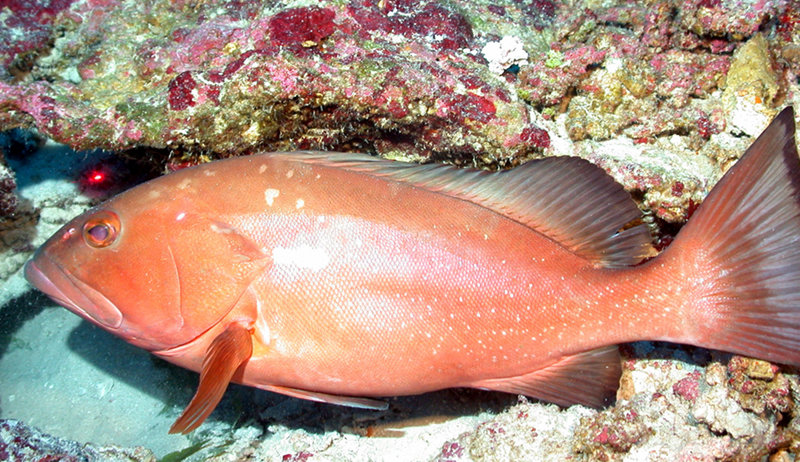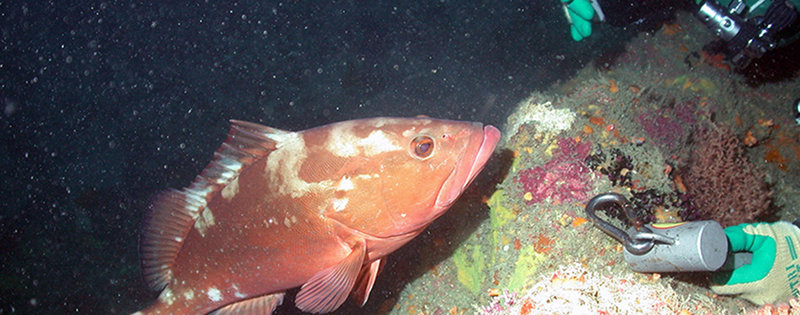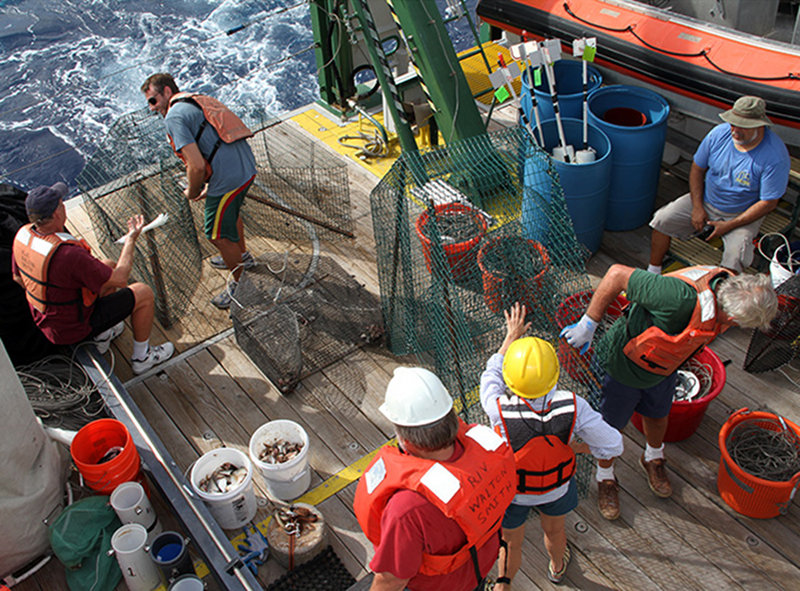
By Felicia Coleman, Director, Coastal and Marine Laboratory - Florida State University
August 14, 2013

An excellent example of a red grouper (Epinephelus morio). These fish dig craters to live in, excavating one mouthful at a time, depositing the material a short distance away. Craters can reach 15’ to 20’ in diameter and 2’ to 3’ deep. Watch for pictures later in the expedition. Image courtesy of Don DeMari. Download larger version (jpg, 1.0 MB).
Hello from the southern tip of Pulley Ridge (PR), a 100+ km-long series of north-south trending drowned barrier islands on the southwest Florida Shelf. Explorations here started in 1869 on the Blake (described by Agassiz), and continued through 1891, resulting in an important discovery: the untapped red snapper population was enormous. By the 1960s, the southwest Florida shelf had become an important red grouper fishing spot for U.S. and Cuban fisheries. The Cuban fishery disappeared with the advent of the Exclusive Economic Zone, while the U.S. fishery continues.
We are on Pulley Ridge to investigate the role that its mesophotic reefs may play in replenishing key fish species, such as grouper and snapper, and other organisms in the downstream reefs of the Florida Keys and Dry Tortugas.

A red grouper checks out a diver. They are curious and often relatively unafraid to approach humans in their midst. Image courtesy of NURC. Download larger version (jpg, 1.2 MB).
Our project, led by the University of Miami, represents a collaboration of over 35 scientists at eleven different universities pooling their expertise with state and federal agency scientists through NOAA’s Cooperative Institute for Marine and Atmospheric Studies in coordination with the Cooperative Institute for Ocean Exploration, Research, and Technology.
Space on the ship is limited, so only a few of the project’s scientists are actually at sea collecting data. The members of the current science team come from six U.S. institutions: Dennis Hanisak, John Reed, Stephanie Farrington, and Brian Cousin of Florida Atlantic University; Felicia Coleman, Christopher Koenig, and Chris Malinowski of Florida State University’s Coastal and Marine Laboratory; Stacey Harter of NOAA National Marine Fisheries Service’s Panama City Laboratory; Lance Horn, Glenn Taylor, and Jason White of the University of North Carolina Wilmington; Cedric Guigand of the University of Miami’s Rosenstiel School of Marine and Atmospheric Science; and Kimberly Puglise of NOAA’s National Centers for Coastal Ocean Science. (Learn more about the team.)

The first deployment of chevron traps upon reaching Pulley Ridge. It’s a type of trap that it is easier to get into than out of. The team is eager to see if any invasive lionfish (Pterois volitans) might come up in the traps along with the target species. Image courtesy of Brian Cousin, FAU Harbor Branch. Download larger version (jpg, 199 KB).
On this research cruise, we have three primary objectives: characterizing the benthic and fish communities using a remotely operated vehicle (ROV), collecting genetic samples of larger fish species using fish traps, and characterizing planktonic fish larval species using plankton nets and light traps.
The ROV operations (masterfully handled by the UNCW trio at the controls of the Undersea Vehicles Program’s Super Phantom ROV) will focus on video and photographic surveys at each dive site to ground truth new multibeam sonar maps, and to quantify and characterize benthic habitats, benthic macro-biota, fish populations, and coral cover especially associated with describing habitat engineered by red grouper.
Organismal sampling is conducted with a combination of MOCNESS nets for larval fish and invertebrates, light traps for settlement-stage fish and invertebrates, and chevron (fish) traps to capture adult fish species. Data gathered from these collections (including biological samples for age, growth, and genetics) are used to inform the biophysical and population dynamics models.
Well, now you know what we think we are going to do. Tomorrow, we’ll start filling you in on what’s really going on. That’s field work for you. Over and out for now from the Gulf of Mexico as we approach Pulley Ridge.